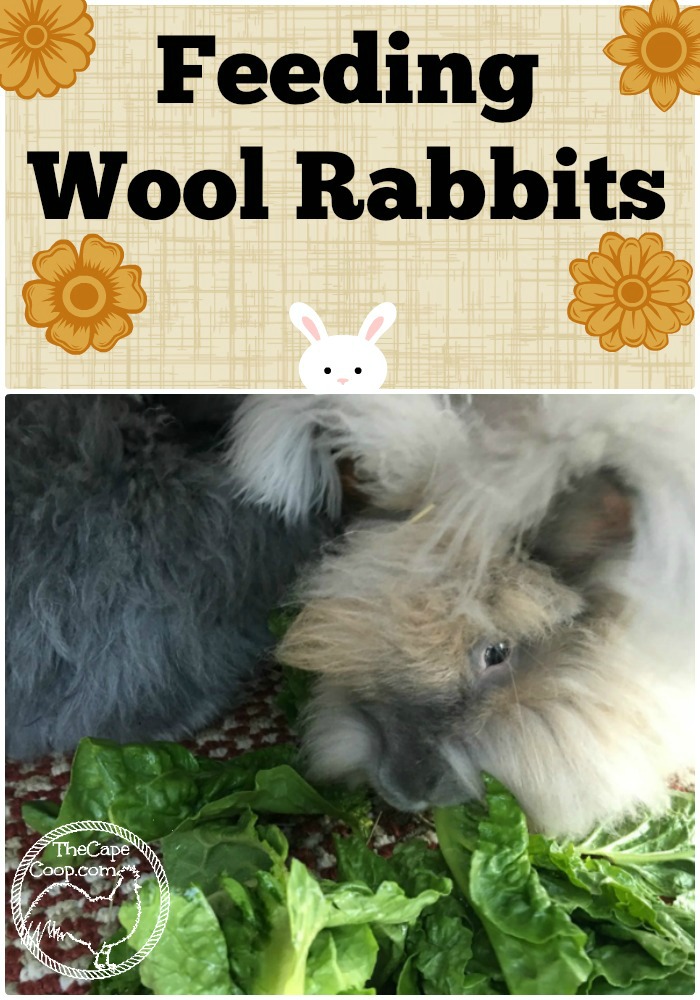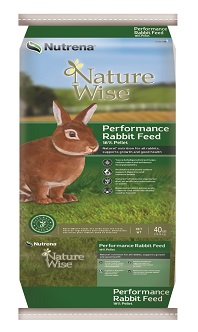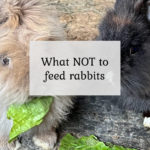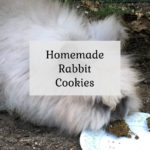---------------------------------------------------------
Feeding your wool-producing rabbits is not always as easy as going to your local pet store and picking up a bag of rabbit pellets. Because Angoras are constantly producing silky soft wool they need a diet higher in protein than your average rabbit. They also need plenty of fresh greens & hay to keep excess wool from building up in their intestines. Wool in the intestines can cause a deadly condition known as wool block or could cause a shutdown of the intestinal system with GI stasis (click here to read more!). So what should you feed your wool rabbits to keep them healthy?
Rabbit Pellets
Wool rabbits should have a pellet feed with 18% protein. It is important to check the protein tags, many commercial pet rabbit brands available only have 14% protein as that is sufficient for most pet rabbits. The higher protein pellets will usually be marked “pro”, “show” or “performance”.
I have yet to find high-protein feed in any of my local pet stores, but my feed store carries some. We feed our rabbits Nutrena’s Nature Wise Performance Rabbit Feed.
The other thing to look for with the feed is an all-pellet feed. Some feed comes with colorful shapes and treats mixed in with the pellets. Your rabbit doesn’t need these treats and will usually dig all these treats out and eat them first. You don’t want them to fill up on snacks first and ignore the pellets! It’s like when you were a kid and your mom would buy you cereal with marshmallows in it and you would go through the box and eat all the marshmallows leaving just the cereal behind.
Don’t buy huge feed bags unless you have several rabbits. It’s hard to keep an open bag of feed fresh for more than a couple of months. Keep the feed in an air-tight container so it doesn’t get stale. For the smaller English Angoras plan on about 1/2 cup pellets per day. For the larger Satin, German, French, & Giant Angoras it will be closer to a cup per day per rabbit.
The pellets should be measured out daily. If they are offered free choice the rabbits will gobble up all their pellets and could become overweight. The only time pellets should be offered free choice is when the kits are under 6 months old. After that, they are fully grown and the pellets should be measured. We use a mesh bottom feeder that attaches to the cage. The wire sifts out any dust and because it is attached to the cage they can’t grab the dish, dump it and toss it around.
Hay
Fresh Timothy hay should be offered daily, free choice. Rabbits should be encouraged to eat as much hay as possible. The roughage is critical to keep their digestive system moving smoothly. Timothy hay is the most popular choice with rabbit keepers, but most grasses can be used.
Alfalfa hay should be avoided (or used very seldom) for adult rabbits as it contains too much calcium for them. Many commercial pellets have alfalfa in them and that is ok, you just don’t want to compound it by also feeding Alfalfa hay. The hay should be replaced daily so it stays fresh and smells inviting for them. Keeping the hay in a manger will keep it cleaner, off the floor, and out of their wool. Try stuffing some hay into a cardboard paper towel or toilet paper tube. Not only will the rabbits eat the hay, but they will also have fun playing with the tube and chewing it up.
Fresh Produce
Fresh vegetables (and fruits in moderation) should also be part of your rabbit’s daily diet. Aim for 1-2 cups of fresh produce per day per rabbit.
In the wild, most of a rabbit’s diet would be foraged greens, berries, and grasses. Just like with humans, providing a varied diet will ensure they get all the vitamins and minerals they need to be healthy.
Most days my rabbits each get half a romaine lettuce head. I try to switch it up when I can by adding in fresh herbs, other dark leafy greens, or slices of fruit or veggies. Great foods to try include romaine lettuce, kale, beet or carrot tops, dandelions, clover, peas, broccoli, and herbs (oregano, mint, parsley, rosemary, lemon balm, thyme & basil seem to be favorites).
Special treats they will love but that should be fed sparingly because they are high in sugar include carrots, dried fruit, melons, berries, apples, bananas, papaya, & pineapple. Foods you should NEVER offer your rabbit include “junk” food like cakes or cookies, salty foods like chips or pretzels, chocolate, raisins, onions, garlic, nuts, or dairy products. Click here to see my recipe for healthy, homemade rabbit cookies!
Supplements
Papaya Vitamin Enzyme Pills are an excellent supplement to your wool rabbit’s diet. It gives them the digestive benefits without the added sugar of eating the fruit fresh. Papaya enzymes help to break down excess fur in the digestive tract preventing wool block. The rabbits LOVE these pills, we usually offer 1-2 pills per week to each rabbit.
Fresh Water
Of course, having fresh water available at all times is just as important as quality food. Your rabbit should never be without clean water, especially in the hot summer months. The water is needed not only to quench thirst but it helps regulate body temperature. Hanging water bottles are a better choice for wool rabbits than a water dish or crock. The water stays cleaner in a hanging bottle and keeps the rabbit from getting their fur wet and matted.










Jolie
Monday 9th of June 2025
Hello, We adopted a smaller size , 1 year old Angora 2 years ago. At three years, he is now having issues with GI stasis. He is indoors. I feed him Timothy Hay, about 1/4 cup of pellets, digestive supplements from Oxbow, and twice a week the Papaya you recommended. We are desperate to find out why after 2 years of no issues, the stasis has hit him twice in last three months. Our rabbit vet said to introduce greens like romaine lettuce, but some places say greens can cause gas. Thank you for any info or recommendations that you may have.
Liz
Tuesday 10th of June 2025
I agree, greens will help his digestive system move along. I feed my rabbits some type of greens every single day. It's usually romaine lettuce but carrot/radish tops, dandelion greens or fresh herbs sometimes get swapped in depending on what I have. Occasionally I'll feed some collard greens or kale. You want to avoid iceberg lettuce and spinach. Does he exercise regularly? As rabbits get older it's natural for them to slow down but it's important for them to stay active for their digestive health. He should be out of his cage for at least 4-5 hours a day with at least 25 square feet to roam. The more space you can give him, the better. Introducing new items to explore like ramps or boxes can encourage exploration and movement. I hope this helps him!
Hayley
Monday 16th of December 2024
Hi everyone,iv recently had a angora rabbit doe, the guy I had her off dosnt know if she's a english angora or a giant angora, I believe she may be a giant angora, she was on mixed bag of food when I got her 3 weeks ago and she felt under weight, ie could feel her spine very easily, she's 23 weeks old now and iv got her on 55g of pellets aday of 18% protein by haygates and a hand full of alfalfa hay as well as plenty of fresh timothy, over 3 weeks she's jumped from 3.90lb to 4.44lb, so my question is am I feeding her enough pellets daily any help will be most appreciated thank you
Liz
Wednesday 18th of December 2024
You definitely should not be able to easily feel her spine so sounds like you are right about her being underweight. But 4 lbs would be super super small for a giant angora so she is likely an English. You are doing an awesome job feeding her, it sounds like she is on a good track now. Keep it up! The only other thing I would suggest is to add some leafy greens to her diet. Some of my rabbit's daily favorites are romaine lettuce, carrot greens, & collard greens and a few times a month I will give them a treat of a few slices of apple, bananas or berries.
Peyton
Tuesday 9th of February 2021
Hey, I’m a new English angora rabbit owner and I just wanted a few tips is all. My angora is 4 months and eats blue seal show pellets (about 1cup), free choice hay , and also a few alfalfa pellets (dumor alfalfa cubes). This is the diet that she has been on with her breeder so I’m deciding to continue this because it seems to be working for her. When should I try incorporating more vegetables and fruits and about how much should I add? Could you give me an idea of a six month diet for her?
I also was wondering if you had grooming tips...I have my handy dandy slicker brush and a hair buster but I didn’t want to rush into grooming her because she just got here a few days ago. I do know however that with angoras it’s essential to groom. I don’t want to feel like I’m forcing her but she is matted especially near her stomach area and neck.I tried to groom a little today just to try to cut off some matts.
Could you also give me tips for potty training? I have a manger hanging over her litter box (filled with pine pellets and hay) but she tends to get hay everywhere and also poops everywhere. Sometimes she uses her box and sometimes she doesn’t. Helpp
Liz
Wednesday 10th of February 2021
Sounds like she is on a good diet for now. What sort of hay are you feeding her? Generally rabbits under 6-7 months get alfalfa hay as it is high in protein for growing rabbits. Once they are older & full grown, you can switch them over to Timothy or Orchard hay. But if you are supplementing her with the alfalfa cubes, that might be why your breeder suggested them. Anytime after 3 months you can begin introducing veggies & fruits. Start with about 1/2 cup per day, working up to 1 cup per day for an adult size rabbit. I would recommend you only introduce one new type of food per week, that way you can monitor her for signs in case something doesn't agree with her.
I recommend you begin grooming as early as possible. When they are little like your rabbit, you really aren't going to be getting a ton of fiber off her, it's mostly to get her used to being handled and brushed. Grooming is such a big part of their life, it's important that she is used to sitting still and being turned upside down so you can get her belly & feet fur. So the earlier you can start getting her used to this the better. I like to start off the young ones with just short grooming sessions - 10 minutes or so - a couple times per week. You can read more about grooming angoras here: https://thecapecoop.com/how-to-groom-angora-rabbits/
She is young still, litter training will come in time. You want to keep a little bit of poop in the box so she gets the scent of it in the box. It's totally normal that she is getting hay every where lol, sometimes they like to dig through the manger to pull out just the right bit of hay. My rabbits are all adults and I would consider them litter trained, but I still find stray poops around the enclosure. They get 100% of their urine in the box and probably 95% of their poops in there. I keep a small dustpan and hand broom in my rabbit area and have made it a habit to sweep up stray poop daily and dump it in their box. Keep it up, she will get there! You can read more about litter training here: https://thecapecoop.com/litter-box-training-rabbits/
DMIS student
Friday 8th of January 2021
I need to know what tower garden food is healthy for angora rabbits.
Liz
Friday 8th of January 2021
Most lettuce mixes are great, the darker the leaf the better. Herbs are also a great bet and easy to grow in a tower system
Niele Da Kine
Monday 25th of November 2019
Aloha Liz!
Just an update to let you know that my suspicions of Nutrena's Nature Wise feed were completely unfounded. It turns out we had gotten Vent Disease in the herd from when we had fostered a baby bun who's mum had died. At least, that's what I think the vector was, but apparently I'm not good at accurate suspicions.
So, in 2018 the whole herd got treated with penicillin to cure the Vent Disease (it's rabbit syphilis but not transferable to humans). We've gone back to using Nutrena's Nature Wise feed AND we're getting baby bunnies again. Yay!
There's more information about bunnies and penicillin on their website if you ever want to know what we did with the bunnies here at Hillside Farm Hawaii. It's on the March 2018 'Old News' and the website should show up on an internet search, should you want to know.
So, Nutrena's Nature Wise high protein feed is good! We do add in a bit of rolled grain of some sort (oats, barley or wheat - not corn) and black oil sunflower seeds but the bunnies are fed in feed dishes attached to the hutch walls with enough room in them that they can dig out the bits they want without spilling the rest. They do eat it all by the time of the next feeding but some of the bunnies like to eat the pellets first and the rolled grain second, other bunnies prefer the grain first, others don't seem to care.
Liz
Monday 25th of November 2019
That is good to hear! It can be so hard to track down the culprit when there is a problem with your animals, so glad you got is sorted out. I will definitely check out your website!